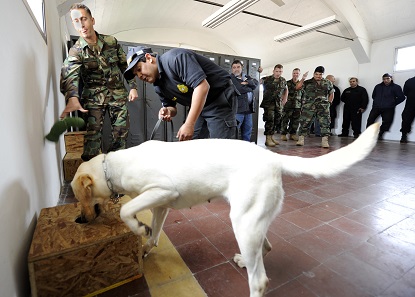by Annika Backe
translated by Teresa Teklic
August 10, 2017 – There is nothing new about dogs being used to detect drugs. Now the four-legged detectives in the United States of America could be used in another operation area: searching for illegally imported antiquities, especially from Iraq and Syria. This measure is taken to contain the unlawful trade with antiquities, which is considered a major financial source of ISIS.
Dogs are soon being trained to detect ancient objects, in a similar fashion as this drug detection dog of the US Navy. Photo: Wikipedia.
In the scope of the project “K9 Artifact Finders” specially trained dogs will be used at American border areas like seaports and airports, meaning those locations in which antiquities enter the country – some of them illegally.
Behind this is the crowdfunded project “RED ARCH Cultural Heritage Law & Policy Research”. According to its website the association is made up of experts from the fields of law and police, museums, arts and the media. RED ARCH, headquartered in Pennsylvania, has made it its business to support politicians, lawyers, troops, curators, auction houses and collectors at home and abroad in their efforts to protect world cultural heritage. For “K9 Artifact Finders” the organisation collaborates with the Penn Vet Working Dog Center, the University of Pennsylvania and the latter’s museum for archaeology and anthropology.
Training the dogs
There is nor prior experience for operations like this. Like drug detection dogs the dogs are trained to detect certain smells. In phase one of the project the dogs are trained to detect artefacts with soil residue. The initiators explicitly state that these artefacts are from recent legal excavations in Iraq.
If the dogs demonstrate their ability to detect the antiquities with certainty, phase two is designed to test the skill “on the road”. If that test is also successful, they will be joining their two-legged colleagues at the borders.
A promising approach?
While this may seem plausible in theory, it is questionable at a closer look. How can the dogs be trained to recognize the smell of the soil from all the different countries from which antiquities are being imported to the US? Can a dog distinguish between legally and illegally excavated antiquities after they have been carefully cleaned? And is it at all smart to employ resources based on an assumption that several investigations have shown to be wrong?
To those who run the project such questions seem irrelevant. So it seems that travellers to the US can be certain to expect the super-noses at the border, working in the service of cultural heritage protection.
Read more about the project at RED ARCH.
This article from Spiegel Online (in German) reports on the successful collaboration of sniffer dogs and archaeology.





